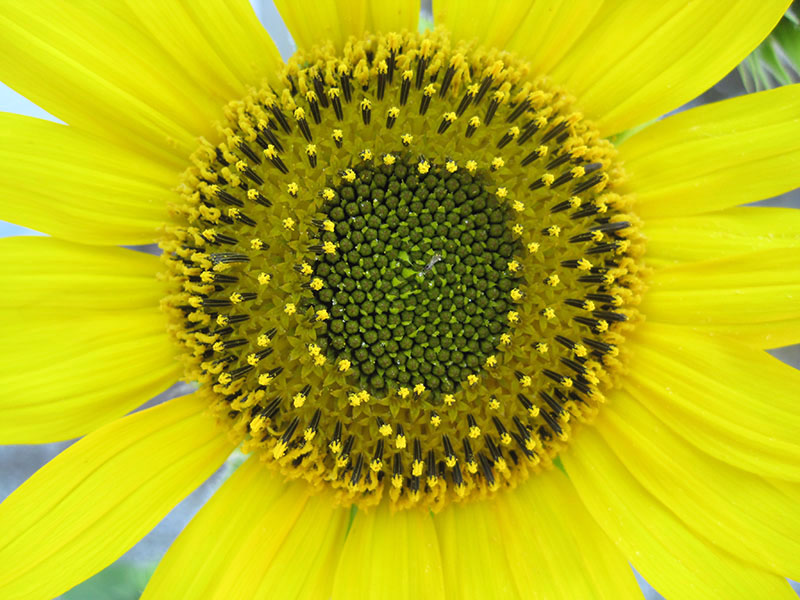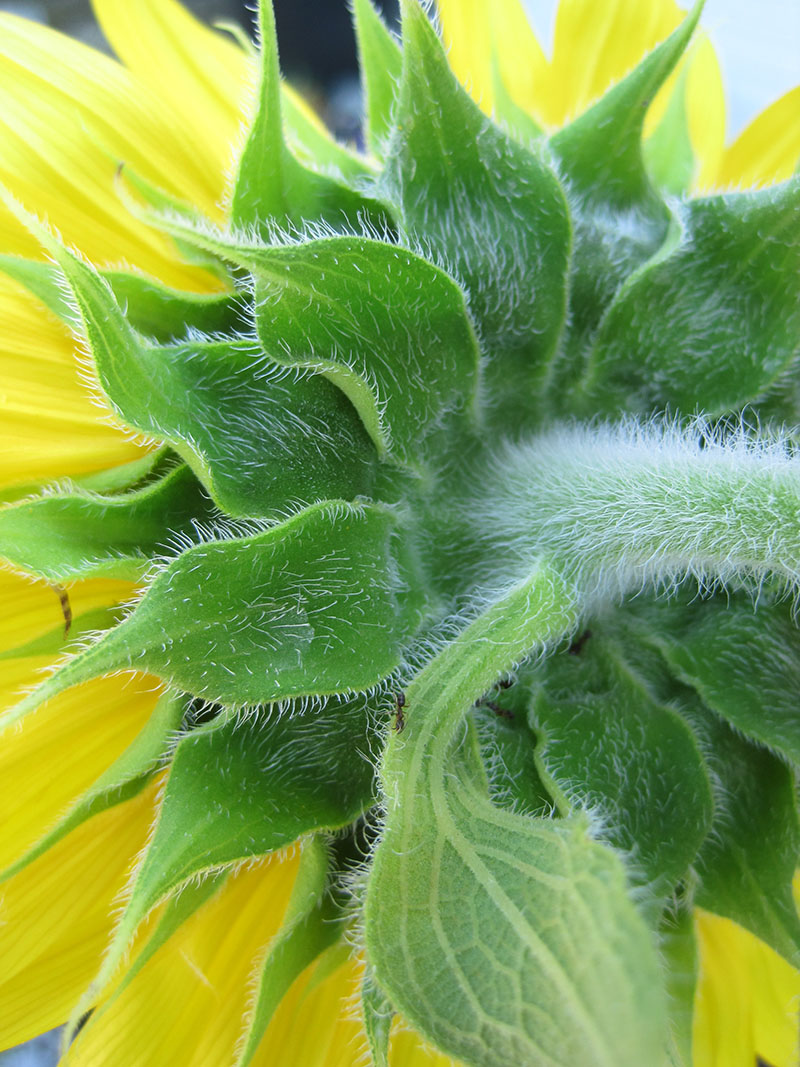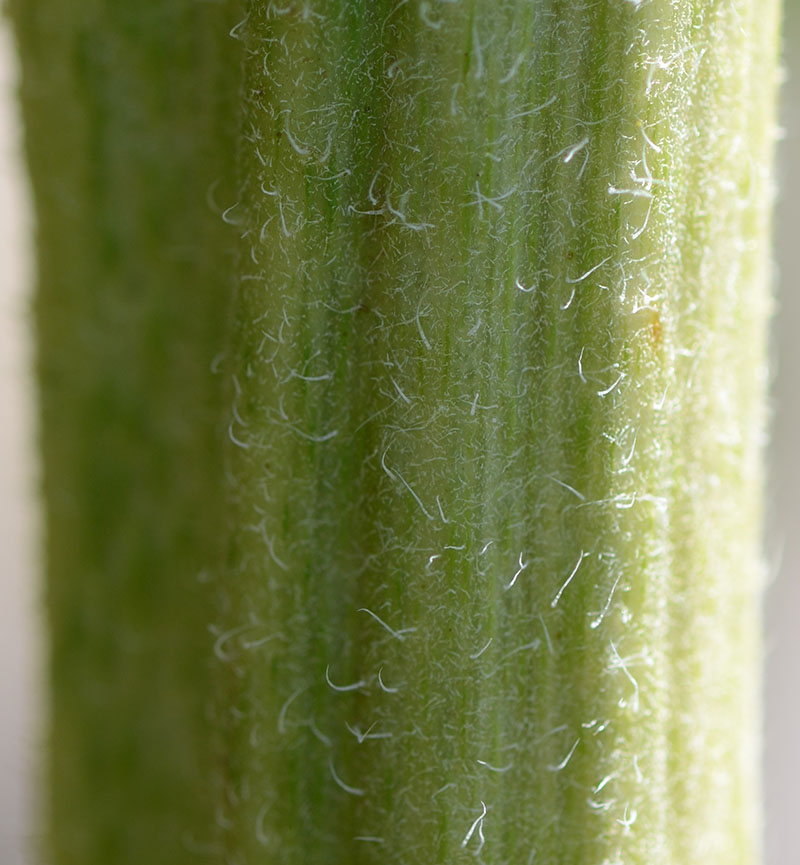Plant of the Week
 Helianthus annuus range map. USDA PLANTS Database.
Helianthus annuus range map. USDA PLANTS Database.
 A. Center of head showing double spiral pattern of fruits (seeds) and yellow pollen on stamens. Photo by David D. Taylor.
A. Center of head showing double spiral pattern of fruits (seeds) and yellow pollen on stamens. Photo by David D. Taylor.
 B. Plants in ruderal habitat along railroad line. Photo by David D. Taylor.
B. Plants in ruderal habitat along railroad line. Photo by David D. Taylor.
 C. Underside of head showing coarse bracts. Photo by David D. Taylor.
C. Underside of head showing coarse bracts. Photo by David D. Taylor.
Common Sunflower (Helianthus annuus L.)
By David Taylor
Common sunflower is a member of the Asteraceae, the Sunflower family. In older manuals and guides, this family is called the Compositae because the 'flowers' are a composite of many flowers, often of different types. The many species of plants in this family are grouped based on the arrangement and type of flowers. All members of the family produce one or more heads (capitulum, the term used in technical keys) of flowers. This and other sunflowers have two different types of flowers, ray flowers and disk flowers and in turn, these can have male and female parts, or either one or the other. The ray flowers look like petals, but each is actually an individual flower. The disc flowers are at the center of the head, inside the ring of ray flowers. The disc flowers are usually small. With a hand lens one can see the distinct tips of 5 petals in each flower. The disc flowers closest to the ray flowers open first. There are 52 species of sunflowers, all native to North America and Mexico.
This sunflower is 1 to 3 meters (ca. 39 to 118 inches) tall (cultivated forms often taller). The stem is stiff, and usually coarsely hairy (see photo D), often more than 2.5 centimeters (1 inches) in diameter. Leaves are mostly alternate, wider at the base than the top, and are 10 to 40 centimeters (4 to 15.75 inches) long by 5 to 40 centimeters (2 to 15.75 inches) wide. The leaves are toothed and covered in short, rough hairs above. Single heads are borne at the end of branches. Each head generally has 13 to 30 ray flowers that are 2.5 to 5 centimeters (1 to 2 inches) long, and 150 to more than a thousand-disc flowers. Both the ray and disc flowers are yellow (reddish rays in some cultivated forms). The center of the head containing the disk flowers is 1.5 to 2.5 mm (0.6 to 1 inches) wide. The entire head is 4.5 to 10.5 centimeters (1.8 to 4.1 inches) wide, much wider in cultivated forms. The involucral bracts under the head are large and leafy (see photo C). This is one of the larger sunflowers found in North America.
Common Sunflower is an open land species, generally on moist soils. It is a species of prairies and other grasslands, old fields, roadsides, railroad rights-of-way, savannas, and forest edge. It is found across the conterminous U.S., but probably is native to the central and southern portion of the range and Mexico. It is also found as an introduction from Nova Scotia to British Columbia, Northwest Territories, Alaska, and Hawai’i. It is cultivated and has escaped in much of the world.
This species flowers in July to October depending on the part of the country in which it is found. Numerous bees, beetles and rarely butterflies are attracted to this plant. Finches, small mammals and insects eat the seeds. The plant is annual, reseeding itself in to suitable areas.
Many things in the plant world are organized in a manner that follows the Fibonacci series (pine cone scales, individual sections of pineapples, garden rose petals). This series of numbers follows the pattern 1, 2, 3, 5, 8, 13, 21, 34, 55…, where each successive number is the sum of the previous two. The spiral pattern of the disc flowers/fruits of this species is an example. The fruits are arranged in two groups of spirals, one to the left and one to the right (see center of photo A). If one counts the number of left hand spirals, and then the number of right hand spirals, the two numbers will be neighbors in the series (typically 21 / 34, 34 / 55, or 55 / 89). A web search for ‘Fibonacci series in nature’ will provide links to more information.


